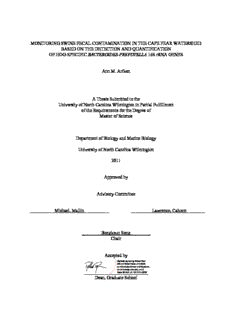Table Of ContentMONITORING SWINE FECAL CONTAMINATION IN THE CAPE FEAR WATERSHED
BASED ON THE DETECTION AND QUANTIFICATION
OF HOG-SPECIFIC BACTEROIDES-PREVOTELLA 16S rRNA GENES
Ann M. Arfken
A Thesis Submitted to the
University of North Carolina Wilmington in Partial Fulfillment
of the Requirements for the Degree of
Master of Science
Department of Biology and Marine Biology
University of North Carolina Wilmington
2011
Approved by
Advisory Committee
Michael, Mallin Lawrence, Cahoon
Bongkeun Song
Chair
Accepted by
____________________________
Dean, Graduate School
TABLE OF CONTENTS
ACKNOWLEDGEMENTS……………………………………………………………………….v
LIST OF TABLES………………………………………………………………………………..vi
LIST OF FIGURES……………………………………………………………………………..viii
CHAPTER 1………………………………………………………………………………………1
ABSTRACT………………………………………………………………………………………2
INTRODUCTION………………………………………………………………………………...4
METHODS………………………………………………………………………………………..8
Sample Collection…………………………………………………………………………8
Hog Lagoons……………………………………………………………………....8
River Samples……………………………………………………………………..8
Nutrient Analysis………………………………………………………………………...10
Coliform Count…………………………………………………………………………..11
Rainfall Data……………………………………………………………………………..11
Molecular Detection……………………………………………………………………...11
DNA Extraction....……………………………………………………………….11
T-RFLP Analysis………………………………………………………………...11
Generating Real-Time PCR Standards…………………………………………..12
Real-Time PCR…………………………………………………………………..13
Statistical Analysis……………………………………………………………….13
RESULTS………………………………………………………………………………………..14
T-RFLP Profile Analysis………………………………………………………………...14
MDS Analysis……………………………………………………………………………15
Quantification of Water Samples By Real-Time PCR Assay……………………………17
Enumeration of Fecal Coliform Counts………………………………………………….21
Nutrient Analyses………………………………………………………………………...22
Ammonium………………………………………………………………………22
ii
Nitrate/Nitrite…………………………………………………………………….23
Total Nitrogen……………………………………………………………………25
Total Phosphorus………………………………………………………………...26
Orthophosphate…………………………………………………………………..27
Dissolved Oxygen………………………………………………………………..28
Chlorophyll a…………………………………………………………………….30
Conductivity……………………………………………………………………...31
Total Suspended Solids (TSS)…………………………………………………...33
Turbidity…………………………………………………………………………34
Temperature……………………………………………………………………...35
pH………………………………………………………………………………...36
Rainfall Amounts………………………………………………………………...37
Correlation Analyses……………………………………………………………..39
DISCUSSION……………………………………………………………………………………42
SUMMARY……………………………………………………………………………………...47
CONCLUSIONS………………………………………………………………………………...48
LITERATURE CITED…………………………………………………………………………..49
CHAPTER 2……………………………………………………………………………………..53
ABSTRACT……………………………………………………………………………………..54
INTRODUCTION……………………………………………………………………………….56
METHODS………………………………………………………………………………………59
Culture Dependent Approach……………………………………………………………59
Sampling…………………………………………………………………………59
Isolation of Antibiotic Resistant Bacteria………………………………………..59
Molecular Identification of Antibiotic Resistant Bacteria……………………….62
Culture Independent Approach…………………………………………………………..62
Sampling…………………………………………………………………………62
iii
DNA Extraction and PCR………………………………………………………..62
Cloning and Sequencing…………………………………………………………63
Analyses………………………………………………………………………………….63
Phylogenetic Analysis……………………………………………………………63
UniFrac Analysis………………………………………………………………...64
RESULTS………………………………………………………………………………………..65
Enumeration of Antibiotic Resistant Bacteria…………………………………………...65
Phylogenetic Analysis…………………………………………………………………....66
Principle Coordinate Analysis (PCoA)…………………………………………………..69
DISCUSSION…………………………………………………………………………………....71
LITERATURE CITED…………………………………………………………………………..74
iv
ACKNOWLEDGEMENTS
This research was funded by WRRI. We would like to acknowledge Rena Haltom and Matthew
McIver for river sampling in 2009-2010. We also thank Kraig Westerbeek and Murphy Brown,
LLC, a division of Smithfield Foods, for providing hog lagoon waste samples from various
locations at North Carolina.
v
LIST OF TABLES
TABLE PAGE
CHAPTER 1
1. Bimonthly levels of Bacteroides-Prevotella 16S rRNA gene copy
numbers in the Cape Fear River Watershed……………………………………………..19
2. Bimonthly fecal coliform counts present in the Cape Fear River
Watershed………………………………………………………………………………..22
3. Bimonthly concentrations of ammonium present in the Cape Fear River
Watershed………………………………………………………………………………..23
4. Bimonthly concentrations of nitrate/nitrite present in the Cape
Fear River Watershed……………………………………………………………………25
5. Bimonthly total nitrogen levels present in the Cape Fear River
Watershed………………………………………………………………………………..26
6. Bimonthly total phosphorus levels present in the Cape Fear River
Watershed………………………………………………………………………………..27
7. Bimonthly concentrations of orthophosphate present in the Cape
Fear River Watershed……………………………………………………………………28
8. Bimonthly concentrations of dissolved oxygen present in the Cape
Fear River Watershed……………………………………………………………………30
9. Bimonthly concentrations of chlorophyll a present in the Cape Fear
River Watershed………………………………………………………………………….31
10. Bimonthly conductivity levels measured in the Cape Fear River
Watershed………………………………………………………………………………..32
11. Bimonthly total suspended solids measurements in the Cape Fear
River Watershed………………………………………………………………………….34
12. Bimonthly turbidity levels measured in the Cape Fear River
Watershed………………………………………………………………………………..35
13. Bimonthly temperatures measurements in the Cape Fear River
Watershed………………………………………………………………………………..36
14. Bimonthly pH measurements in the Cape Fear River Watershed………………….........37
vi
PAGE
14. Bimonthly total rainfall measurements 3 days prior to sampling in
the Cape Fear River Watershed…………………………………………………….........38
16. Bimonthly total rainfall measurements on the day of sampling in the
Cape Fear River Watershed……………………………………………………...............39
17. Correlation coefficients ( R ) between Bacteroides-Prevotella 16S
rRNA gene copy numbers and physical/nutrient parameters……………………………41
CHAPTER 2
1. Colony counts for antibiotic treatment plates……………………………………………65
2. Number of isolates or clones sequenced…………………………………………………66
vii
LIST OF FIGURES
FIGURE PAGE
CHAPTER 1
1. Locations of sampling sites in the Cape Fear River Watershed…………………………10
2. Representative hog lagoon and river T-RFLP profiles…………………………………..15
3. MDS plot of Bacteroides-Prevotella communities in hog lagoons
and bimonthly sampling sites based on T-RFLP peak similarity………………………..16
4. Bubble plot of relative abundance of bp 229-230 T-RF in hog
lagoons and bimonthly sampling sites…………………………………………………...17
5. Comparison graphs of Bacteroides-Prevotella 16S rRNA gene copy
numbers in the Cape Fear River Watershed……………………………………………..20
CHAPTER 2
1. Hog lagoon and sprayfield sampling flow chart…………………………………………61
2. Phylogenetic tree based on 16S rRNA gene sequences………………………………….68
3. Weighted UniFrac PCoA analyses basd on 16S rRNA gene
sequences for different antibiotic treatments and hog environments…………………….7
viii
CHAPTER 1: MONITORING SWINE FECAL CONTAMINATION IN THE CAPE FEAR
RIVER WATERSHED BASED ON THE DETECTION AND QUANTIFICATION OF HOG-
SPECIFIC BACTEROIDES-PREVOTELLA 16S RRNA GENES
ABSTRACT
Monitoring fecal contamination in watersheds is important from both a human health and
ecological perspective, especially in areas where concentrated animal feeding operations
(CAFOs) are abundant. One such area is the lower Cape Fear River watershed, where
approximately 5,000,000 head of swine are housed in CAFOs along major tributaries of the
watershed, including the Black and Northeast Cape Fear Rivers. In order to evaluate hog waste
contamination in the lower Cape Fear River watershed, we examined surface water samples from
hog lagoons and streams within the Black River and the Northeast Cape Fear River watersheds
using molecular microbiogical techniques including Terminal Restriction Fragment Length
Polymorphism (T-RFLP) and Quantitative PCR (Q-PCR) of Bacteroides 16S rDNA.
Environmental parameters including physical and geochemical characteristics of water samples
and coliform counts were measured to determine correlations with the Q-PCR data. T-RFLP
analyses showed similar community structures of Bacteroides groups in the hog lagoons and
varying community structures in the river samples. However, the dominant bp 229-230 T-RFs
found in the hog lagoon samples did not correspond to hog-specific peaks found in previous
studies, limiting this technique’s usefulness for host-specific identification. In addition, Q-PCR
data of hog-specific Bacteroides-Prevotella 16S rRNA gene numbers did not correlate to the
relative abundance of the bp 229-230 T-RF in the river samples. Based on the Q-PCR results,
however, sites PB (Panther Branch) and BC117 (Burgaw Creek and Highway 117) in the
Northeast Cape Fear River watershed and site 6RC (Six Runs Creek) in the Black River
watershed had the highest overall and most consistent levels of hog waste contamination. In the
Northeast Cape Fear River watershed, hog waste contamination was highest at sites located
immediately downstream from hog related activities. In the Black River, the highest level of
2
Description:Ann M. Arfken .. using molecular microbiogical techniques including Terminal Restriction . The goals of this research were (i) to detect swine.

